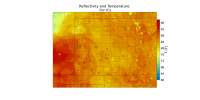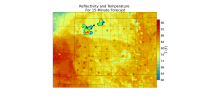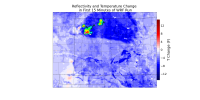Hi WRF folks,
I've noticed that the surface temperatures in WRF simulations I'm running for 8 June 2019 are unreasonably cold after ~22 UTC (in some places in the open warm sector away from storms they're ~10-20 F too cold by the end of a several-hour simulation). Furthermore, temperatures are also too cold under cloud cover and drop 3-6 F+ in the first 15 minutes of the simulation from reasonable initial conditions. I found that changing the icloud variable in the namelist from 1 to 0 made the temperatures under cloud cover much more reasonable, and changing the isfflx variable from 1 to 0 makes the surface temperatures away from convection more reasonable. From reading some of the WRF documentation, it sounds like I should have both of these parameters set to 1 for real-data cases, so I was wondering if having them set to 0 was ok and if there was anything else in the namelist which might be causing this issue. I've attached the namelist I've been using, and I've also listed the main physics settings I've been using below:
mp_physics = 17
ra_lw_physics = 1
ra_sw_physics = 1
radt = 3,
sf_sfclay_physics = 1,
sf_surface_physics = 3,
num_soil_layers = 6,
bl_pbl_physics = 1,
bldt = 0,
cu_physics = 0,
cudt = 0,
isfflx = 1,
ifsnow = 1,
icloud = 1,
surface_input_source = 3,
num_land_cat = 21,
sf_urban_physics = 0,
sf_ocean_physics = 0,
do_radar_ref = 1,
I've noticed that the surface temperatures in WRF simulations I'm running for 8 June 2019 are unreasonably cold after ~22 UTC (in some places in the open warm sector away from storms they're ~10-20 F too cold by the end of a several-hour simulation). Furthermore, temperatures are also too cold under cloud cover and drop 3-6 F+ in the first 15 minutes of the simulation from reasonable initial conditions. I found that changing the icloud variable in the namelist from 1 to 0 made the temperatures under cloud cover much more reasonable, and changing the isfflx variable from 1 to 0 makes the surface temperatures away from convection more reasonable. From reading some of the WRF documentation, it sounds like I should have both of these parameters set to 1 for real-data cases, so I was wondering if having them set to 0 was ok and if there was anything else in the namelist which might be causing this issue. I've attached the namelist I've been using, and I've also listed the main physics settings I've been using below:
mp_physics = 17
ra_lw_physics = 1
ra_sw_physics = 1
radt = 3,
sf_sfclay_physics = 1,
sf_surface_physics = 3,
num_soil_layers = 6,
bl_pbl_physics = 1,
bldt = 0,
cu_physics = 0,
cudt = 0,
isfflx = 1,
ifsnow = 1,
icloud = 1,
surface_input_source = 3,
num_land_cat = 21,
sf_urban_physics = 0,
sf_ocean_physics = 0,
do_radar_ref = 1,



